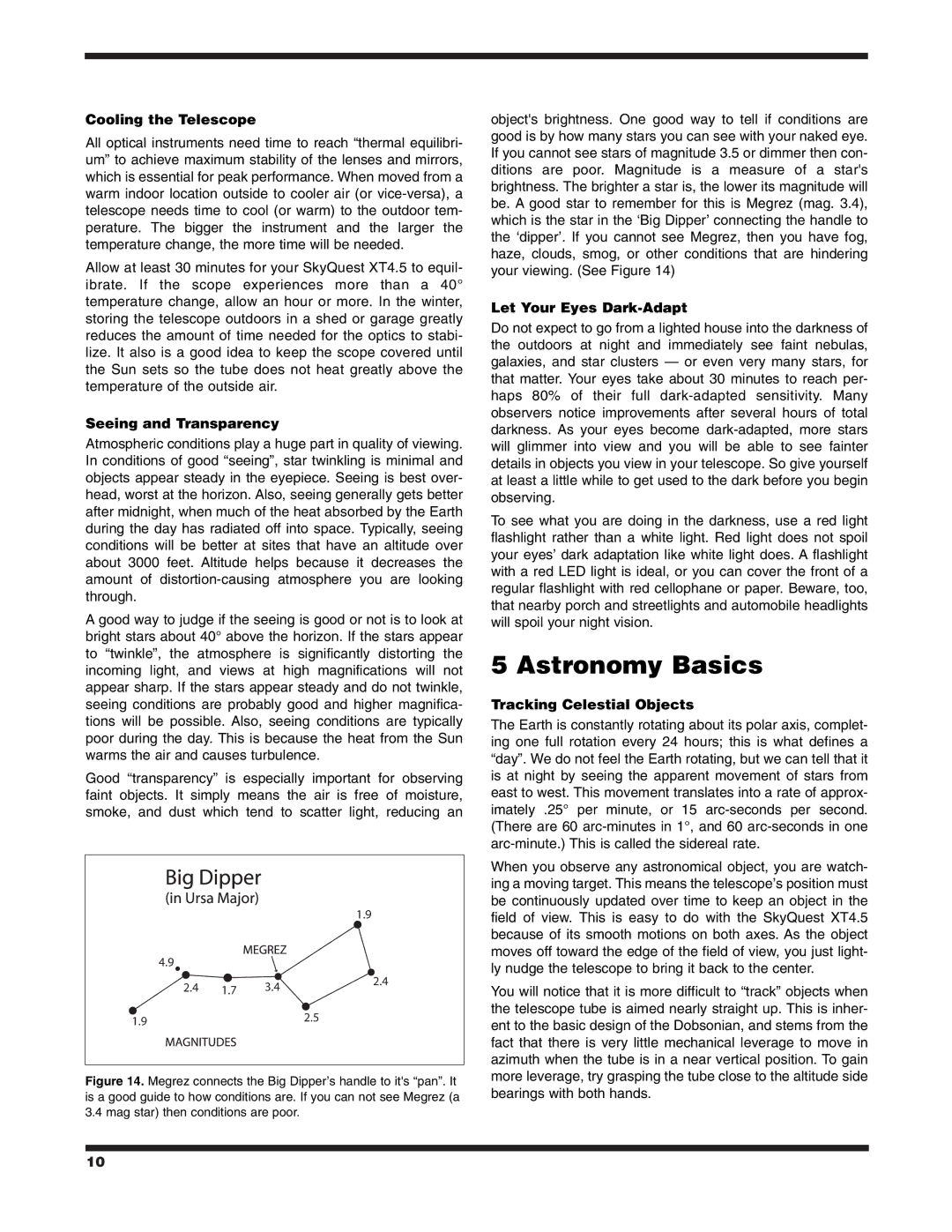
Cooling the Telescope
All optical instruments need time to reach “thermal equilibri- um” to achieve maximum stability of the lenses and mirrors, which is essential for peak performance. When moved from a warm indoor location outside to cooler air (or
Allow at least 30 minutes for your SkyQuest XT4.5 to equil- ibrate. If the scope experiences more than a 40° temperature change, allow an hour or more. In the winter, storing the telescope outdoors in a shed or garage greatly reduces the amount of time needed for the optics to stabi- lize. It also is a good idea to keep the scope covered until the Sun sets so the tube does not heat greatly above the temperature of the outside air.
Seeing and Transparency
Atmospheric conditions play a huge part in quality of viewing. In conditions of good “seeing”, star twinkling is minimal and objects appear steady in the eyepiece. Seeing is best over- head, worst at the horizon. Also, seeing generally gets better after midnight, when much of the heat absorbed by the Earth during the day has radiated off into space. Typically, seeing conditions will be better at sites that have an altitude over about 3000 feet. Altitude helps because it decreases the amount of
A good way to judge if the seeing is good or not is to look at bright stars about 40° above the horizon. If the stars appear to “twinkle”, the atmosphere is significantly distorting the incoming light, and views at high magnifications will not appear sharp. If the stars appear steady and do not twinkle, seeing conditions are probably good and higher magnifica- tions will be possible. Also, seeing conditions are typically poor during the day. This is because the heat from the Sun warms the air and causes turbulence.
Good “transparency” is especially important for observing faint objects. It simply means the air is free of moisture, smoke, and dust which tend to scatter light, reducing an
|
|
| 1.9 |
4.9 |
|
|
|
2.4 | 1.7 | 3.4 | 2.4 |
| |||
1.9 |
|
| 2.5 |
|
|
|
Figure 14. Megrez connects the Big Dipper’s handle to it's “pan”. It is a good guide to how conditions are. If you can not see Megrez (a 3.4 mag star) then conditions are poor.
object's brightness. One good way to tell if conditions are good is by how many stars you can see with your naked eye. If you cannot see stars of magnitude 3.5 or dimmer then con- ditions are poor. Magnitude is a measure of a star's brightness. The brighter a star is, the lower its magnitude will be. A good star to remember for this is Megrez (mag. 3.4), which is the star in the ‘Big Dipper’ connecting the handle to the ‘dipper’. If you cannot see Megrez, then you have fog, haze, clouds, smog, or other conditions that are hindering your viewing. (See Figure 14)
Let Your Eyes Dark-Adapt
Do not expect to go from a lighted house into the darkness of the outdoors at night and immediately see faint nebulas, galaxies, and star clusters — or even very many stars, for that matter. Your eyes take about 30 minutes to reach per- haps 80% of their full
To see what you are doing in the darkness, use a red light flashlight rather than a white light. Red light does not spoil your eyes’ dark adaptation like white light does. A flashlight with a red LED light is ideal, or you can cover the front of a regular flashlight with red cellophane or paper. Beware, too, that nearby porch and streetlights and automobile headlights will spoil your night vision.
5 Astronomy Basics
Tracking Celestial Objects
The Earth is constantly rotating about its polar axis, complet- ing one full rotation every 24 hours; this is what defines a “day”. We do not feel the Earth rotating, but we can tell that it is at night by seeing the apparent movement of stars from east to west. This movement translates into a rate of approx- imately .25° per minute, or 15
When you observe any astronomical object, you are watch- ing a moving target. This means the telescope’s position must be continuously updated over time to keep an object in the field of view. This is easy to do with the SkyQuest XT4.5 because of its smooth motions on both axes. As the object moves off toward the edge of the field of view, you just light- ly nudge the telescope to bring it back to the center.
You will notice that it is more difficult to “track” objects when the telescope tube is aimed nearly straight up. This is inher- ent to the basic design of the Dobsonian, and stems from the fact that there is very little mechanical leverage to move in azimuth when the tube is in a near vertical position. To gain more leverage, try grasping the tube close to the altitude side bearings with both hands.
10
